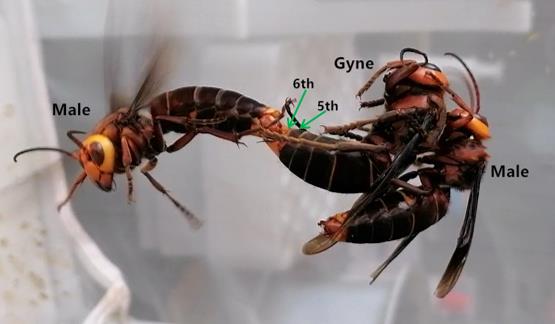In a correspondence published in Current Biology, researchers have identified three active compounds in sex pheromones produced by virgin queens of the species Vespa mandarinia, the world’s largest hornet. When placed in field traps, synthetic compounds of these compounds and a queen-equivalent mixture rapidly attracted hundreds of males instead of females or other species.
Vespa mandarinia has been recently found outside its native range and may threaten native bees and honeybees as well as harm bee-pollinated crop production. Therefore, controlling its reproduction by learning more about the giant hornet’s reproductive biology and developing trapping methods to locate its nests is a matter of great urgency.
In this study, researchers from the Xishuangbanna Tropical Botanical Garden (XTBG) of the Chinese Academy of Sciences and their collaborators collected sexually mature virgin queens and drones with insect nets as they emerged from three colonies in Yunnan, China.
“When we placed a queen inside a cage with males, the males immediately clustered around the queen and intensively antennated and tried to mate with her,” said DONG Shihao of XTBG.
Using coupled gas chromatography electroantennogram detection, they found that all three major pheromone components identified by the study—hexanoic acid, octanoic acid, and decanoic acid—elicited strong responses from male antennae. Pure synthetic compounds or a queen-equivalent mixture also elicited strong responses from male antennae.
In addition, the researchers tried to determine whether the identified compounds would help trap males in the field. Their results showed significant success.
“Given the urgent need to monitor the spread of V. mandarinia in North America and control its reproduction, we suggest that immediate testing of these sex pheromone components and their mixture would be beneficial, while studies to identify additional queen sex pheromone components are being carried out,” said TAN Ken of XTBG.
Contact
TAN Ken Ph.D Principal Investigator
Key Laboratory of Tropical Forest Ecology, Xishuangbanna Tropical Botanical Garden, Chinese Academy of Sciences, Mengla, Yunnan 666303, China
E-mail: kentan@xtbg.ac.cn

Giant hornet preys on honey bees. (Image by DONG Shihao)

Giant hornet males mating with queen. (Image by DONG Shihao)
Link: https://www.eurekalert.org/news-releases/946264


